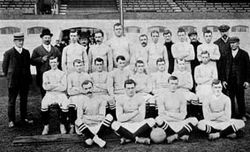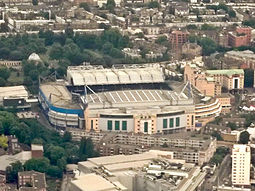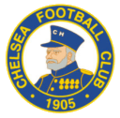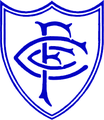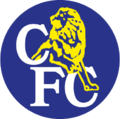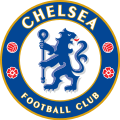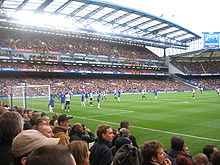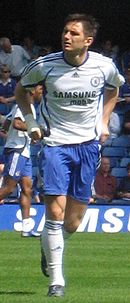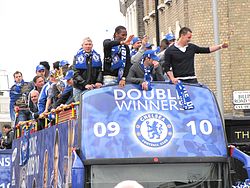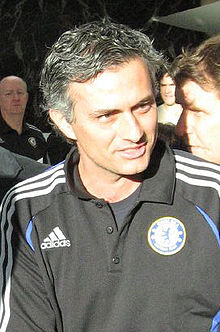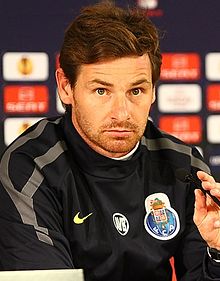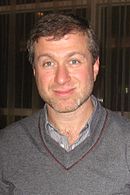- Chelsea F.C.
-
Chelsea 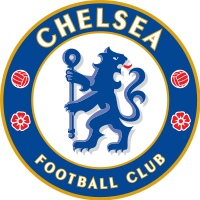
Full name Chelsea Football Club Nickname(s) The Pensioners (until 1952)
The Blues (present)Founded 10 March 1905[1] Ground Stamford Bridge
(Capacity: 41,841[2])Owner Roman Abramovich Chairman Bruce Buck Manager André Villas-Boas League Premier League 2010–11 Premier League, 2nd Website Club home page Home coloursAway coloursThird colours Current season
Current seasonChelsea Football Club (
 /ˈtʃɛlsiː/) are an English football club based in West London. Founded in 1905, they play in the Premier League and have spent most of their history in the top tier of English football. Chelsea have been English champions four times, FA Cup winners six times and League Cup winners four times. They have also been successful in Europe, winning the UEFA Cup Winners' Cup twice.[3]
/ˈtʃɛlsiː/) are an English football club based in West London. Founded in 1905, they play in the Premier League and have spent most of their history in the top tier of English football. Chelsea have been English champions four times, FA Cup winners six times and League Cup winners four times. They have also been successful in Europe, winning the UEFA Cup Winners' Cup twice.[3]The club had their first major success in 1955, when they won the league championship. Chelsea won several cup competitions during the 1960s and 1970s, but after that did not win another major title until 1997. The past decade has been the most successful period in Chelsea’s history, capped by winning Premier League titles in 2005, 2006 and 2010, the latter as part of their first league and FA Cup "Double".
Despite their name, the club is not based in Chelsea, but in neighbouring Fulham. The club's home is the 41,841 capacity Stamford Bridge football stadium in Fulham,[2] where they have played since their establishment. Since 2003 they have been owned by Russian billionaire Roman Abramovich.[4]
Chelsea's regular kit colours are royal blue shirts and shorts with white socks, the combination used since the 1960s. The club crest has been changed several times in attempts to modernise or re-brand; the current crest, featuring a ceremonial lion holding a staff, is a modified version of one first adopted in the 1950s.[5] The club has sustained the fifth highest average all-time attendance in English football.[6] Their average home gate for the 2010–11 season was 41,435, the sixth highest in the Premier League.[7]
Contents
History
For information on the current season, see Chelsea F.C. season 2010–11.Chelsea were founded on 10 March 1905 at The Rising Sun pub (now The Butcher's Hook),[8] opposite the present-day main entrance to the ground on Fulham Road, and were elected to the Football League shortly afterwards. The club's early years saw little success; the closest they came to winning a major trophy was reaching the 1915 FA Cup Final, where they lost to Sheffield United. Chelsea gained a reputation for signing big-name players[9] and for being entertainers, but made little impact on the English game in the inter-war years.
Former Arsenal and England centre-forward Ted Drake became manager in 1952 and proceeded to modernise the club. He removed the club's Chelsea pensioner crest, improved the youth set-up and training regime, rebuilt the side, and led Chelsea to their first major trophy success – the League championship – in 1954–55. The following season saw UEFA create the European Champions' Cup, but after objections from The Football League and the FA Chelsea were persuaded to withdraw from the competition before it started.[10]
They challenged for honours throughout the 1960s, and endured several near-misses. They were on course for a treble of League, FA Cup and League Cup going into the final stages of the 1964–65 season, winning the League Cup but faltering late on in the other two.[11] In three seasons the side were beaten in three major semi-finals and were FA Cup runners-up. Chelsea won the FA Cup in 1970, beating Leeds United 2–1 in a final replay. Chelsea took their first European honour, a UEFA Cup Winners' Cup triumph, the following year, with another replayed win, this time over Real Madrid in Athens.
The late 1970s through to the 1980s was a turbulent period for Chelsea. An ambitious redevelopment of Stamford Bridge threatened the financial stability of the club,[12] star players were sold and the team were relegated. Further problems were caused by a notorious hooligan element among the support, which was to plague the club throughout the decade.[13] In 1982 Chelsea were, at the nadir of their fortunes, acquired by Ken Bates for the nominal sum of £1, although by now the Stamford Bridge freehold had been sold to property developers, meaning the club faced losing their home.[14] On the pitch, the team had fared little better, coming close to relegation to the Third Division for the first time, but in 1983 manager John Neal put together an impressive new team for minimal outlay. Chelsea won the Second Division title in 1983–84 and established themselves in the top division, before being relegated again in 1988. The club bounced back immediately by winning the Second Division championship in 1988–89.
After a long-running legal battle, Bates reunited the stadium freehold with the club in 1992 by doing a deal with the banks of the property developers, who had been bankrupted by a market crash.[15] Chelsea's form in the new Premier League was unconvincing, although they did reach the 1994 FA Cup Final. It was not until the appointment of former European Footballer of the Year Ruud Gullit as player-manager in 1996 that their fortunes changed. He added several top-class international players to the side, as the club won the FA Cup in 1997 and established themselves as one of England's top sides again. Gullit was replaced by Gianluca Vialli, who led the team to victory in the League Cup Final and the Cup Winners' Cup Final in 1998, the FA Cup in 2000 and the UEFA Champions League quarter-finals in 2000. Vialli was sacked in favour of another Italian, Claudio Ranieri, who guided Chelsea to the 2002 FA Cup Final and Champions League qualification in 2002–03.
In June 2003, Bates sold Chelsea to Russian billionaire Roman Abramovich for £140 million, completing what was then the biggest-ever sale of an English football club.[4] Over £100 million was spent on new players, but Ranieri was unable to deliver any trophies, so he was replaced by Portuguese coach José Mourinho. Under Mourinho, Chelsea became the fifth English team to win back-to-back league championships since the Second World War (2004–05 and 2005–06),[16] in addition to winning an FA Cup (2007) and two League Cups (2005 and 2007). In September 2007 Mourinho was replaced by Avram Grant,[17] who led the club to their first UEFA Champions League final, which they lost on penalties to Manchester United. Grant was fired days later[18] and succeeded by Luiz Felipe Scolari in July 2008.[19]
Scolari spent only seven months in the job before being dismissed after a string of poor results.[20] Russia coach Guus Hiddink was appointed caretaker manager until the end of the 2008–09 season,[21] and guided Chelsea to a second FA Cup triumph in three years.[22] Two days later, former Milan coach Carlo Ancelotti was confirmed as Chelsea's new manager.[23] In his first season, Ancelotti led Chelsea to their first league and FA Cup "Double"; in addition, Chelsea became the first English top-flight side to score over 100 league goals in a season since 1963.[24] Ancelotti parted company with Chelsea in May 2011 and was replaced by then Porto coach André Villas-Boas.[25]
Stamford Bridge

Chelsea have only ever had one home ground, Stamford Bridge, where they have played since foundation. It was officially opened on 28 April 1877. For the first 28 years of its existence it was used almost exclusively by the London Athletics Club as an arena for athletics meetings and not at all for football. In 1904 the ground was acquired by businessman Gus Mears and his brother Joseph, who had previously acquired additional land (formerly a large market garden) with the aim of staging football matches on the now 12.5 acre (51,000 m²) site.[26]
Stamford Bridge was designed for the Mears family by the noted football architect Archibald Leitch.[27] They offered to lease the stadium to Fulham, but were turned down. As a consequence, the owners decided to form their own football club to occupy their new ground. Most football clubs were founded first, and then sought grounds in which to play, but Chelsea were founded for Stamford Bridge. Since there was already a football club named Fulham in the borough, the founders decided to adopt the name of the adjacent borough of Chelsea for the new club, having also considered names such as Kensington FC, Stamford Bridge FC and London FC.[28]
Starting with an open bowl-like design and one covered terrace, Stamford Bridge had an original capacity of around 100,000.[26] The early 1930s saw the construction of a terrace on the southern part of the ground with a roof that covered around one fifth of the stand. It eventually became known as the "Shed End", the home of Chelsea's most loyal and vocal supporters, particularly during the 1960s, 70s and 80s. The exact origins of the name are unclear, but the fact that the roof looked like a corrugated iron shed roof played a part.[26]
During the late 1960s and early 70s, the club's owners embarked on a modernisation of Stamford Bridge with plans for a 50,000 all-seater stadium.[26] Work began on the East Stand in the early 1970s but the project was beset with problems and the cost almost brought the club to its knees, culminating in the freehold being sold to property developers. Following a long legal battle, it was not until the mid-1990s that Chelsea's future at the stadium was secured and renovation work resumed.[26] The north, west and southern parts of the ground were converted into all-seater stands and moved closer to the pitch, a process completed by 2001.
When Stamford Bridge was redeveloped in the Ken Bates era many additional features were added to the complex including two hotels, apartments, bars, restaurants, the Chelsea Megastore, and an interactive visitor attraction called Chelsea World of Sport. The intention was that these facilities would provide extra revenue to support the football side of the business, but they were less successful than hoped and before the Abramovich takeover in 2003 the debt taken on to finance them was a major burden on the club. Soon after the takeover a decision was taken to drop the "Chelsea Village" brand and refocus on Chelsea as a football club. However, the stadium is sometimes still referred to as part of "Chelsea Village" or "The Village".
The Stamford Bridge freehold, the pitch, the turnstiles and Chelsea's naming rights are now owned by Chelsea Pitch Owners, a non-profit organisation in which fans are the shareholders. The CPO was created to ensure the stadium could never again be sold to developers. As a condition for using the Chelsea FC name, the club has to play its first team matches at Stamford Bridge, which means that if the club moves to a new stadium, they may have to change their name.[29] Chelsea's training ground is located in Cobham, Surrey. Chelsea moved to Cobham in 2004. Their previous training ground in Harlington was taken over by QPR in 2005.[30] The new training facilities in Cobham were completed in 2007.[31]
The club plans to increase the capacity of Stamford Bridge to over 50,000. Owing to its location in a built-up part of London on a main road and next to two railway lines, fans can only enter the stadium through the Fulham Road entrances, which places severe constraints on expansion due to health and safety regulations.[32] As a result, Chelsea have been linked with a move away from Stamford Bridge to sites including the Earls Court Exhibition Centre, Battersea Power Station and the Chelsea Barracks.[33] However, the club have consistently affirmed their desire to keep Chelsea at their current home.[34][35][36] On 3 October 2011, Chelsea made a proposal to CPO shareholders to buy back the freehold to the land on which Stamford Bridge sits, stating that "buying back the freehold removes a potential hurdle should a suitable site become available in the future".[37]
Stamford Bridge has been used for a variety of other sporting events since 1905. It hosted the FA Cup Final from 1920 to 1922,[38] has held ten FA Cup semi-finals (most recently in 1978), ten FA Charity Shield matches (the last in 1970), and three England international matches, the last in 1932; it was also the venue for an unofficial Victory International in 1946.[39] In October 1905 it hosted a rugby union match between the All Blacks and Middlesex,[40] and in 1914 hosted a baseball match between the touring New York Giants and the Chicago White Sox.[41] It was the venue for a boxing match between world flyweight champion Jimmy Wilde and Joe Conn in 1918.[42] The running track was used for dirt track racing between 1928 and 1932,[43] greyhound racing from 1937 to 1968, and Midget car racing in 1948.[44] In 1980, Stamford Bridge hosted the first international floodlit cricket match in the UK, between Essex and the West Indies.[45] It was also the home stadium of the London Monarchs American Football team for the 1997 season.[46]
Crest
Since the club's foundation, Chelsea have had four main crests, though all underwent minor variations. In 1905, Chelsea adopted as their first crest the image of a Chelsea pensioner, which obviously contributed to the "pensioner" nickname, and remained for the next half-century, though it never appeared on the shirts. As part of Ted Drake's modernisation of the club from 1952 onwards, he insisted that the pensioner badge be removed from the match day programme in order to change the club's image and that a new crest be adopted.[47] As a stop-gap, a temporary emblem comprising simply the initials C.F.C. was adopted for one year.
In 1953, Chelsea's crest was changed to an upright blue lion looking backwards and holding a staff, which was to endure for the next three decades. This crest was based on elements in the coat of arms of the Metropolitan Borough of Chelsea[48] with the "lion rampant regardant" taken from the arms of then club president Viscount Chelsea and the staff from the Abbots of Westminster, former Lords of the Manor of Chelsea. It also featured three red roses, to represent England, and two footballs. This was the first club badge to appear on shirts, since the policy of putting the crest on the shirts was only adopted in the early 1960s.[47]
In 1986, with Ken Bates now owner of the club, Chelsea's crest was changed again as part of another attempt to modernise and to capitalise on new marketing opportunities.[47] The new badge featured a more naturalistic non-heraldic lion, in white and not blue, standing over the C.F.C. initials. It lasted for the next 19 years, with some modifications such as the use of different colours, such as red from 1987 to 1995, and yellow from 1995 until 1999, before the white returned[49]. With new ownership, and the club's centenary approaching, combined with demands from fans for the club's traditional badge to be restored, it was decided that the crest should be changed again in 2004. The new crest was officially adopted for the start of the 2005–06 season and marks a return to the older design of the blue heraldic lion holding a staff.[5] As with previous crests, this one has appeared in various colours, including white and gold.
Colours
Chelsea's first home colours, used from 1905 until c.1912. Chelsea have always worn blue shirts, although they initially adopted a lighter shade than the current version, and unlike today wore white shorts and dark blue socks. The lighter blue was taken from the racing colours of then club president, Earl Cadogan. The light blue shirts were short-lived, however, and replaced by a royal blue version in around 1912.[50] In the 1960s Chelsea manager Tommy Docherty changed the kit again, switching to blue shorts (which have remained ever since) and white socks, believing it made the club's colours more modern and distinctive, since no other major side used that combination; this kit was first worn during the 1964–65 season.[51] Since then Chelsea have always worn white socks with their home kit apart from a short spell from 1985 to 1992, when blue socks were reintroduced.
Chelsea's traditional away colours are all yellow or all white with blue trim, but, as with most teams, they have had some more unusual ones. The first away strip consisted of black and white stripes and for one game in the 1960s the team wore blue and black stripes, inspired by Inter Milan's kit, again at Docherty's behest.[52] Other memorable away kits include a mint green strip in the 1980s, a red and white checked one in the early 90s and a graphite and tangerine edition in the mid-1990s.[53]
Chelsea's kit is currently manufactured by Adidas, which is contracted to supply the club's kit from 2006 to 2018. The contract was extended on 22 October 2010.[54] Previously, the kit was manufactured by Umbro (1968–81), Le Coq Sportif (1981–86), The Chelsea Collection (1986–87) and Umbro again (1987–2006). Chelsea's first shirt sponsor was Gulf Air, agreed midway through the 1983–84 season. Following that, the club were sponsored by Grange Farms, Bai Lin Tea and Italian company Simod before a long-term deal was signed with computer manufacturer Commodore International in 1989; Amiga, an off-shoot of Commodore, also appeared on the shirts. Chelsea were subsequently sponsored by Coors beer (1995–97), Autoglass (1997–2001) and Emirates Airline (2001–05). Chelsea's current shirt sponsor is Samsung[55] who took over the sponsorship from their mobile division in 2007–08.
Supporters and rivalries
Chelsea have the fifth highest average all-time attendance in English football[56] and regularly attract over 40,000 fans to Stamford Bridge; they were the fifth best-supported Premier League team in the 2009–10 season, with an average gate of 41,472.[7] Chelsea's traditional fanbase comes from all over the Greater London area including working-class parts such as Hammersmith and Battersea, wealthier areas like Chelsea and Kensington, and from the home counties. There are also numerous official supporters clubs in the United Kingdom and all over the world.[57]
At matches Chelsea fans sing chants such as "Carefree" (to the tune of Lord of the Dance, whose lyrics were probably written by supporter Mick Greenaway[58][59]), "Ten Men Went to Mow", "We All Follow the Chelsea" (to the tune of Land of Hope and Glory), "Zigga Zagga", and the celebratory "Celery", with the latter often resulting in fans ritually throwing celery. The vegetable was banned inside Stamford Bridge after an incident involving Arsenal midfielder Cesc Fàbregas at the 2007 League Cup Final.[60]
Chelsea do not have a traditional rivalry on the scale of the Merseyside derby or the North London derby, and their West London derby with Fulham or Queens Park Rangers has not been as prominent over the years with due to the clubs often spending time in separate divisions. A 2004 survey by Planetfootball.com found that Chelsea fans consider their main rivalries to be with (in order): Arsenal, Tottenham Hotspur and Manchester United.[61] Their rivalry with Tottenham Hotspur is said to have developed following the 1967 FA Cup Final, the first cup final held between two London clubs. Additionally, a strong rivalry with Leeds United dates back to several heated and controversial matches in the 1960s and 1970s, particularly the 1970 FA Cup Final.[62] More recently, a rivalry has grown with Liverpool following repeated clashes in cup competitions.[63]
During the 1970s and 1980s in particular, Chelsea supporters were associated with football hooliganism. The club's "football firm", originally the Chelsea Shed Boys, now known as the Chelsea Headhunters, were nationally notorious for violent acts against hooligans from other teams, such as West Ham United's Inter City Firm and Millwall's Bushwackers, both during and after matches.[64] The increase in hooliganism in the 1980s led chairman Ken Bates to propose erecting an electric fence to deter them from invading the pitch; the proposal was rejected by the GLC.[65] Since the 1990s there has been a marked decline in crowd trouble at matches, as a result of stricter policing, CCTV in grounds and the advent of all-seater stadia.[66] According to Home Office statistics 126 Chelsea fans were arrested for football-related offences during the 2009–10 season, the third highest in the division, and 27 banning orders were issued, the fifth highest in the division.[67]
Records
Chelsea's highest appearance-maker is ex-captain Ron Harris, who played in 795 first-class games for the club between 1961 and 1980.[68] This record is unlikely to be broken in the near future; Chelsea's current highest appearance-maker is Frank Lampard with 524.[69] The record for a Chelsea goalkeeper is held by Harris's contemporary, Peter Bonetti, who made 729 appearances (1959–79). With 89 caps (87 while at the club), Frank Lampard of England is Chelsea's most capped international player.
Bobby Tambling is Chelsea's all-time top goalscorer, with 202 goals in 370 games (1959–70).[68] Eight other players have also scored over 100 goals for Chelsea: George Hilsdon (1906–12), George Mills (1929–39), Roy Bentley (1948–56), Jimmy Greaves (1957–61), Peter Osgood (1964–74 and 1978–79), Kerry Dixon (1983–92), Frank Lampard (2001–) and Didier Drogba (2004–). With 193 goals, Dixon is the only player to have come close to matching Tambling's record. Greaves holds the record for the most goals scored in one season (43 in 1960–61). Lampard is the top scorer currently at the club with 177.[69]
Officially, Chelsea's highest home attendance is 82,905 for a First Division match against Arsenal on 12 October 1935. However, an estimated crowd of over 100,000 attended a friendly match against Soviet team Dynamo Moscow on 13 November 1945.[70] The modernisation of Stamford Bridge during the 1990s and the introduction of all-seater stands mean that neither record will be broken for the foreseeable future. The current legal capacity of Stamford Bridge is 41,841.[2]
Chelsea hold numerous records in English and European football. They hold the record for the highest ever points total for a league season (95), the fewest goals conceded during a league season (15), the highest number of Premier League victories in a season (29), the highest number of clean sheets overall in a Premier League season (25) (all set during the 2004–05 season),[71] and the most consecutive clean sheets from the start of a league season (6, set during the 2005–06 season).[72]
The club's 21–0 aggregate victory over Jeunesse Hautcharage in the UEFA Cup Winners' Cup in 1971 remains a record in European competition.[73] Chelsea hold the record for the longest streak of unbeaten matches at home in the English top-flight, which lasted 86 matches from 20 March 2004 to 26 October 2008. They secured the record on 12 August 2007, beating the previous record of 63 matches unbeaten set by Liverpool between 1978 and 1980.[74][75] Chelsea's streak of eleven consecutive away league wins, set between 5 April 2008 and 6 December 2008, is also a record for the English top flight.[76]
Chelsea have recorded several "firsts" in English football. Along with Arsenal, they were the first club to play with shirt numbers on 25 August 1928 in their match against Swansea Town.[77] Chelsea were the first English side to travel by aeroplane to a domestic away match, when they visited Newcastle United on 19 April 1957,[78] and the first First Division side to play a match on a Sunday, when they faced Stoke City on 27 January 1974. On 26 December 1999, Chelsea became the first British side to field an entirely foreign starting line-up (no British or Irish players) in a Premier League match against Southampton.[79] On 19 May 2007, they became the first team to win the FA Cup at the new Wembley Stadium, having also been the last to win it at the old Wembley.[80] After the conclusion of the 2007–08 season, Chelsea became the highest ranked club under UEFA's five-year coefficient system used in the seeding of European club competitions in the following season, the first English club to do so in the 21st century.[81] On the final day of the 2009–10 season, Chelsea became the first team in Premier League history to score at least 100 goals in a single season.[24]
Popular culture
In 1930, Chelsea featured in one of the earliest football films, The Great Game.[82] One-time Chelsea centre forward, Jack Cock, who by then was playing for Millwall, was the star of the film and several scenes were shot at Stamford Bridge, including the pitch, the boardroom, and the dressing rooms. It included guest appearances by then-Chelsea players Andrew Wilson, George Mills, and Sam Millington.[83] Owing to the notoriety of the Chelsea Headhunters, a football firm associated with the club, Chelsea have also featured in films about football hooliganism, including 2004's The Football Factory.[84] Chelsea also appear in the Hindi film Jhoom Barabar Jhoom.[85]
Up until the 1950s, the club had a long-running association with the music halls, with their underachievement often providing material for comedians such as George Robey.[86] It culminated in comedian Norman Long's release of a comic song in 1933, ironically titled "On the Day That Chelsea Went and Won the Cup", the lyrics of which describe a series of bizarre and improbable occurrences on the hypothetical day when Chelsea finally won a trophy.[9]
The song "Blue is the Colour" was released as a single in the build-up to the 1972 League Cup Final, with all members of Chelsea's first team squad singing; it reached number five in the UK Singles Chart.[87] (The song was later adopted, as an anthem, by the Vancouver Whitecaps in Canada, after being changed to "White is the Colour".[88]) In the build-up to the 1997 FA Cup Final, the song "Blue Day", performed by Suggs and members of the Chelsea squad, reached number 22 in the UK charts.[89] Bryan Adams, a fan of Chelsea,[90] dedicated the song "We're Gonna Win" from the album 18 Til I Die to the club.[91]
Chelsea Ladies
Chelsea also operate a women's football team, Chelsea Ladies. It has been affiliated to the men's team since 2004,[92] and is part of the club's Community Development programme. They play their home games at Imperial Fields, the home ground of Isthmian League club Tooting & Mitcham United.[93] The club won the Surrey County Cup in 2003, 2004, 2006, 2007, 2008, 2009 and 2010,[94] and were promoted to the Premier Division for the first time in 2005 as Southern Division champions. In the 2009–10 season, they finished 3rd in the Premier League, equalling their highest ever placing, and in 2010 were one of the eight founder members of the FA Women's Super League.[95] John Terry, the current captain of the Chelsea men's team, is President of Chelsea LFC.[96]
Players
- As of 31 August 2011.[97]
Current squad
Note: Flags indicate national team as has been defined under FIFA eligibility rules. Players may hold more than one non-FIFA nationality.
No. Position Player 1 
GK Petr Čech 2 
DF Branislav Ivanović 3 
DF Ashley Cole 4 
DF David Luiz 5 
MF Michael Essien 6 
MF Oriol Romeu 7 
MF Ramires 8 
MF Frank Lampard (vice-captain) 9 
FW Fernando Torres 10 
MF Juan Mata 11 
FW Didier Drogba 12 
MF John Obi Mikel 15 
MF Florent Malouda No. Position Player 16 
MF Raul Meireles 17 
DF José Bosingwa 18 
FW Romelu Lukaku 19 
DF Paulo Ferreira 20 
MF Josh McEachran 21 
FW Salomon Kalou 22 
GK Ross Turnbull 23 
FW Daniel Sturridge 26 
DF John Terry (club captain) 33 
DF Alex 34 
DF Ryan Bertrand 39 
FW Nicolas Anelka 40 
GK Henrique Hilário Out on loan
Note: Flags indicate national team as has been defined under FIFA eligibility rules. Players may hold more than one non-FIFA nationality.
No. Position Player 13 
GK Thibaut Courtois (at Atlético Madrid until the end of 2011–12 season) 30 
MF Yossi Benayoun (at Arsenal until the end of the 2011–12 season) 38 
DF Patrick van Aanholt (at Wigan Athletic until the end of 2011–12 season) No. Position Player 43 
DF Jeffrey Bruma (at Hamburger SV until the end of 2011–12 season) 44 
MF Gaël Kakuta (at Bolton Wanderers until January 1 2012) 46 
MF Ulises Dávila (at Vitesse until the end of 2011–12 season) Reserves and Academy team
For the reserve and academy team squads, see Chelsea F.C. Reserves and Academy
Player of the Year
Year Winner 1967  Peter Bonetti
Peter Bonetti1968  Charlie Cooke
Charlie Cooke1969  David Webb
David Webb1970  John Hollins
John Hollins1971  John Hollins
John Hollins1972  David Webb
David Webb1973  Peter Osgood
Peter Osgood1974  Gary Locke
Gary Locke1975  Charlie Cooke
Charlie Cooke1976  Ray Wilkins
Ray Wilkins1977  Ray Wilkins
Ray Wilkins1978  Micky Droy
Micky Droy1979  Tommy Langley
Tommy Langley1980  Clive Walker
Clive Walker1981  Petar Borota
Petar Borota1982  Mike Fillery
Mike Fillery1983  Joey Jones
Joey Jones1984  Pat Nevin
Pat Nevin1985  David Speedie
David Speedie1986  Eddie Niedzwiecki
Eddie Niedzwiecki1987  Pat Nevin
Pat Nevin1988  Tony Dorigo
Tony Dorigo1989  Graham Roberts
Graham RobertsYear Winner 1990  Ken Monkou
Ken Monkou1991  Andy Townsend
Andy Townsend1992  Paul Elliott
Paul Elliott1993  Frank Sinclair
Frank Sinclair1994  Steve Clarke
Steve Clarke1995  Erland Johnsen
Erland Johnsen1996  Ruud Gullit
Ruud Gullit1997  Mark Hughes
Mark Hughes1998  Dennis Wise
Dennis Wise1999  Gianfranco Zola
Gianfranco Zola2000  Dennis Wise
Dennis Wise2001  John Terry
John Terry2002  Carlo Cudicini
Carlo Cudicini2003  Gianfranco Zola
Gianfranco Zola2004  Frank Lampard
Frank Lampard2005  Frank Lampard
Frank Lampard2006  John Terry
John Terry2007  Michael Essien
Michael Essien2008  Joe Cole
Joe Cole2009  Frank Lampard
Frank Lampard2010  Didier Drogba
Didier Drogba2011  Petr Čech
Petr ČechNotable managers
The following managers won at least one trophy when in charge of Chelsea:
Name Period Trophies  Ted Drake
Ted Drake1952–1961 First Division Championship, Charity Shield  Tommy Docherty
Tommy Docherty1962–1967 League Cup  Dave Sexton
Dave Sexton1967–1974 FA Cup, UEFA Cup Winners' Cup  John Neal
John Neal1981–1985 Second Division Championship  John Hollins
John Hollins1985–1988 Full Members Cup  Bobby Campbell
Bobby Campbell1988–1991 Second Division Championship, Full Members Cup  Ruud Gullit
Ruud Gullit1996–1998 FA Cup  Gianluca Vialli
Gianluca Vialli1998–2000 FA Cup, League Cup, Charity Shield, UEFA Cup Winners' Cup, UEFA Super Cup  José Mourinho
José Mourinho2004–2007 2 Premier Leagues, 2 League Cups, FA Cup, Community Shield  Guus Hiddink
Guus Hiddink2009 FA Cup  Carlo Ancelotti
Carlo Ancelotti2009–2011 Premier League, FA Cup, Community Shield Coaching staff
Position Staff Manager  André Villas-Boas
André Villas-BoasAssistant first team coach  Roberto Di Matteo
Roberto Di MatteoAssistant first team coach  Steve Holland
Steve HollandTechnical director  Michael Emenalo
Michael EmenaloGoalkeeper coach  Christophe Lollichon
Christophe LollichonFirst team fitness coach  José Mario Rocha
José Mario RochaAssistant first team fitness coach  Chris Jones
Chris JonesHead opposition scout  Daniel Sousa
Daniel SousaSenior opposition scout  Mick McGiven
Mick McGivenMedical director  Paco Biosca
Paco BioscaReserve team manager  Dermot Drummy
Dermot DrummyYouth team manager  Adrian Viveash
Adrian ViveashAcademy manager  Neil Bath
Neil BathMatch analyst  James Melbourne
James MelbourneSource: Chelsea F.C. Club hierarchy
Chelsea Ltd.
- Owner: Roman Abramovich
Chelsea F.C. plc
- Chairman: Bruce Buck
- Directors: Ron Gourlay and Eugene Tenenbaum
Executive Board
- Chief Executive: Ron Gourlay
- Finance and Operations Director : Chris Alexander
- Club Secretary : David Barnard
- Company Secretary : Alan Shaw
Chelsea Football Club Board:
Bruce Buck, Eugene Tenenbaum, Ron Gourlay, David Barnard, Mike Forde.Life President:
Lord Richard AttenboroughHonours
Domestic
-
- Winners (4): 1954–55, 2004–05, 2005–06, 2009–10
- Runners-up (4): 2003–04, 2006–07, 2007–08, 2010–11
-
- Winners (2): 1983–84, 1988–89
- Runners-up (5): 1906–07, 1911–12, 1929–30, 1962–63, 1976–77
-
- Winners (2): 1985–86, 1989–90
European
-
- Runners-up (1): 2007–08
-
- Winners (2): 1970–71, 1997–98
-
- Winners (1): 1998
Footnotes
- ^ "TEAM HISTORY – INTRODUCTION". Chelsea F.C. Website. http://www.chelseafc.com/page/TeamHistory/0,,10268,00.html. Retrieved 11 May 2011.
- ^ a b c "Club Info". chelseafc.com. http://www.chelseafc.com/page/ClubInfo/0,,10268,00.html. Retrieved 30 May 2009.
- ^ "Trophy Cabinet". chelseafc.com. http://www.chelseafc.com/xxchelsea180706/index.html#/page/TrophyCabinet. Retrieved 25 January 2007.
- ^ a b "Russian businessman buys Chelsea". BBC Sport. 2 July 2003. http://news.bbc.co.uk/1/hi/business/3036838.stm. Retrieved 11 February 2007.
- ^ a b "Chelsea centenary crest unveiled". BBC Sport. 12 November 2004. http://news.bbc.co.uk/sport1/hi/football/teams/c/chelsea/4008257.stm. Retrieved 2 January 2007.
- ^ "All Time League Attendance Records". http://nufc.com/2011-12html/attendance-all-time.html. Retrieved 17 July 2011.
- ^ a b Kempster, Tony. "Attendances 2009/10". http://www.tonykempster.co.uk/prematt.htm?comp=1. Retrieved 22 May 2010.
- ^ "Team History". Chelsea FC. http://www.chelseafc.com/page/TeamHistory/0,,10268~1800325,00.html. Retrieved 11 March 2010.
- ^ a b Brian Glanville (10 January 2004). "Little sign of change for Chelsea and their impossible dreams". The Times (UK). http://www.timesonline.co.uk/tol/sport/football/article992039.ece. Retrieved 15 March 2009.
- ^ Brian Glanville (27 April 2005). "The great Chelsea surrender". The Times (UK). http://www.timesonline.co.uk/article/0,,762-1586242,00.html. Retrieved 29 December 2006.
- ^ Glanvill, Rick (2006). Chelsea FC: The Official Biography – The Definitive Story of the First 100 Years. Headline Book Publishing Ltd. p. 196. ISBN 978-075531466-9.
- ^ Glanvill (2006). Chelsea FC: The Official Biography. pp. 84–87.
- ^ Glanvill (2006). Chelsea FC: The Official Biography. pp. 143–157.
- ^ Glanvill (2006). Chelsea FC: The Official Biography. pp. 89–90.
- ^ Glanvill (2006). Chelsea FC: The Official Biography. pp. 90–91.
- ^ Matt Barlow (12 March 2006). "Terry Eyes Back-to-Back Titles". Sporting Life. http://www.sportinglife.com/story_get.cgi?STORY_NAME=soccer/06/03/12/SOCCER_Chelsea.html&TEAMHD=soccer. Retrieved 22 January 2007.
- ^ "Chelsea name Grant as new manager". BBC Sport. 20 September 2007. http://news.bbc.co.uk/sport1/hi/football/teams/c/chelsea/7004083.stm. Retrieved 21 September 2007.
- ^ "Grant sacked as Chelsea manager". BBC Sport. 24 May 2008. http://news.bbc.co.uk/sport1/hi/football/teams/c/chelsea/7418774.stm. Retrieved 24 August 2009.
- ^ "Scolari is new Chlesea manager". Chelsea FC. http://www.chelseafc.com/xxchelsea180706/index.html#/page/Homepage/article_1326948. Retrieved 11 June 2008.
- ^ "Chelsea sack Scolari". FIFA.com. 9 February 2009. http://www.fifa.com/worldfootball/clubfootball/news/newsid=1021097.html?cid=rssfeed&att=. Retrieved 24 August 2009.
- ^ "Chelsea confirm Hiddink as coach". BBC Sport. 11 February 2009. http://news.bbc.co.uk/sport1/hi/football/teams/c/chelsea/7882667.stm. Retrieved 11 February 2009.
- ^ "Chelsea 2–1 Everton". BBC Sport. 30 May 2009. http://news.bbc.co.uk/sport2/hi/football/fa_cup/8060989.stm. Retrieved 1 June 2009.
- ^ "Carlo Ancelotti signs three-year deal with Chelsea". The Guardian. 6 January 2009. http://www.guardian.co.uk/football/2009/jun/01/carlo-ancelotti-chelsea-three-years. Retrieved 6 February 2011.
- ^ a b "Chelsea 8–0 Wigan". BBC Sport. 9 May 2010. http://news.bbc.co.uk/sport1/hi/football/eng_prem/8663686.stm. Retrieved 16 May 2010.
- ^ "Andre Villas-Boas confirmed as Chelsea manager". BBC Sport. 22 June 2011. http://news.bbc.co.uk/sport1/hi/football/13858858.stm. Retrieved 22 June 2011.
- ^ a b c d e "Stadium History". chelseafc.com. http://www.chelseafc.com/xxchelsea180706/index.html#/page/StadiumHistoryHistory. Retrieved 21 January 2007.
- ^ Glanvill (2006). Chelsea FC: The Official Biography. pp. 69–71.
- ^ Glanvill (2006). Chelsea FC: The Official Biography. p. 55.
- ^ Glanvill (2006). Chelsea FC: The Official Biography. pp. 91–92.
- ^ Veysey, Wayne (24 May 2005), QPR take over Chelsea training ground, Evening Standard
- ^ Chelsea's New Training Ground For The Future BBC London, 5 July 2007
- ^ Glanvill (2006). Chelsea FC: The Official Biography. p. 76.
- ^ "Chelsea plan Bridge redevelopment". BBC Sport. 20 January 2006. http://news.bbc.co.uk/sport1/hi/football/teams/c/chelsea/4630618.stm. Retrieved 1 January 2007.
- ^ "Kenyon confirms Blues will stay at Stamford Bridge". RTÉ Sport. 12 April 2006. http://www.rte.ie/sport/2006/0412/stamfordbridge.html?rss. Retrieved 1 January 2007.
- ^ "Observer Stadium Story Denied". Chelseafc.com. 9 November 2008. http://www.chelseafc.com/page/LatestNews/0,,10268~1448876,00.html. Retrieved 19 March 2011.
- ^ "Chelsea deny they're to ditch Stamford Bridge for 60,000 stadium at Earls Court". Daily Mail (UK). 10 November 2010. http://www.dailymail.co.uk/sport/football/article-1328071/Chelsea-deny-Earls-Court-ditch-Stamford-Bridge.html. Retrieved 19 March 2011.
- ^ "Chelsea FC Proposal To Chelsea Pitch Owners". Chelseafc.com. http://www.chelseafc.com/page/LatestNews/0,,10268~2471443,00.html. Retrieved 03 October 2011.
- ^ "Cup Final Statistics". TheFA.com. http://www.thefa.com/TheFACup/FACompetitions/TheFACup/History/CupFinalResults. Retrieved 18 February 2011.
- ^ "England's Matches: Unofficial". Englandfootballonline. http://www.englandfootballonline.com/MatchRsl/MatchRslUnoff.html. Retrieved 18 February 2011.
- ^ "All Blacks". Rugbyfootballhistory.com. http://www.rugbyfootballhistory.com/allblacks.html. Retrieved 18 February 2011.
- ^ "Countdown to SABR Day 2011". BaseballGB.co.uk. http://www.baseballgb.co.uk/?p=9582. Retrieved 18 February 2011.
- ^ "Jimmy Wilde: The Original Explosive Thin Man". Cyberboxingzone.com. http://cyberboxingzone.com/boxing/casey/MC_Wilde.htm. Retrieved 18 February 2011.
- ^ "Stamford Bridge Speedway". guskuhn.net. http://www.guskuhn.net/GKuhn/Stamford%20Bridge/StamfordBrdgIndex.htm. Retrieved 18 February 2011.
- ^ "U.S. Invades England 1948". speedcarworld.com. http://www.speedcarworld.com.au/default.asp?Page=Release&Id=8958. Retrieved 19 February 2011.
- ^ "Twenty20 before Twenty20". spincricket.com. http://www.spincricket.com/tag/invention-of-twenty20/. Retrieved 18 February 2011.
- ^ "London Monarchs". Britballnow.co.uk. http://www.britballnow.co.uk/History/Britball%20Teams/LONDONMONARCHS.htm. Retrieved 19 February 2011.
- ^ a b c "Club Badges". chelseafc.com. http://www.chelseafc.com/xxchelsea180706/index.html#/page/ClubBadges. Retrieved 21 January 2007.
- ^ "CHELSEA METROPOLITAN BOROUGH COUNCIL". Civic Heraldry of England and Wales. http://www.civicheraldry.co.uk/lcc.html#chelsea%20bc. Retrieved 21 January 2007.
- ^ Moor, Dave. "Historical Kits - Chelsea". Historical Kits. http://www.historicalkits.co.uk/Chelsea/Chelsea.htm. Retrieved 28 September 2011.
- ^ Glanvill, Rick (2006). Chelsea Football Club: The Official History in Pictures. ISBN 0-7553-1467-0. p. 212
- ^ Mears, Brian (2002). Chelsea: Football Under the Blue Flag. Mainstream Sport. p. 42. ISBN 1-84018-658-5.
- ^ The "Inter Milan" kit was worn for an FA Cup semi-final against Sheffield Wednesday, on 23 April 1966. Reference: Mears (2002), p. 58
- ^ All kits are discussed on the club's official website "Kits". chelseafc.com. http://www.chelseafc.com/xxchelsea180706/index.html#/page/ClassicKits. Retrieved 1 January 2007.
- ^ "ADIDAS GLOBAL PARTNERSHIP EXTENDED". Chelsea F.C. Website. 22 October 2010. http://www.chelseafc.com/page/LatestNews/0,,10268~2192734,00.html. Retrieved 23 June 2011.
- ^ Ashling O'Connor (2 May 2005). "Clubs to cash in on mobile advertising". The Times (UK). http://www.timesonline.co.uk/tol/sport/football/article387503.ece. Retrieved 21 January 2010.
- ^ "All Time League Attendance Records". NUFC.com. 14 July 2011. http://nufc.com/2011-12html/attendance-all-time.html. Retrieved 18 September 2011.
- ^ "Supporters Clubs Map". Chelseafc.com. http://www.chelseafc.com/page/SupporterClubsMap/0,,10268,00.html. Retrieved 21 February 2011.
- ^ Glanvill (2006). Chelsea FC: The Official Biography. p. 150.
- ^ ""Carefree" audio sample". Fanchants.com. http://fanchants.com/football-songs/chelsea-chants/carefree/. Retrieved 2011-09-03.
- ^ Scott Murray (17 April 2002). "Fans sent spinning after tossing salad". The Guardian. http://football.guardian.co.uk/News_Story/0,1563,685859,00.html. Retrieved 1 January 2007.
- ^ "Football Rivalries: The Complete Results". Planetfootball.com. http://www.thefootballnetwork.net/main/s120/st44186.htm. Retrieved 2 January 2007.
- ^ Glanvill (2006). Chelsea FC: The Official Biography. pp. 321–325.
- ^ "Six very modern football rivalries". TalkSport. 19 May 2011. http://www.talksport.co.uk/magazine/features/2011-05-19/peterborough-v-mk-dons-liverpool-v-chelsea-stoke-v-cardiff-six-best-modern-football-rivalries. Retrieved 23 May 2011.
- ^ "Making a new start". BBC News. 2 May 2002. http://news.bbc.co.uk/1/hi/programmes/hooligans/1962503.stm. Retrieved 21 January 2007.
- ^ "Bates: Chelsea's driving force". BBC Sport. 2 July 2003. http://news.bbc.co.uk/sport1/hi/football/teams/c/chelsea/3037508.stm. Retrieved 21 January 2007.
- ^ "Soccer hooliganism: Made in England, but big abroad". BBC News. 2 June 1998. http://news.bbc.co.uk/1/hi/special_report/1998/hooligans/60146.stm. Retrieved 1 January 2007.
- ^ "Statistics on football-related arrests and banning orders" (PDF). Home Office. November 2010. http://www.homeoffice.gov.uk/publications/crime/football-arrests-banning-orders/fbo-2009-10?view=Binary. Retrieved 14 May 2011.
- ^ a b For the appearance and goalscoring records of all Chelsea players, see Glanvill (2006). Chelsea FC: The Official Biography. pp. 399–410.
- ^ a b "soccerbase.com". http://www.soccerbase.com/. Retrieved 13 December 2009.
- ^ "Team History". chelseafc.com. http://www.chelseafc.com/xxchelsea180706/index.html#/page/TeamHistory. Retrieved 21 January 2007.
- ^ "Mourinho proud of battling finish". BBC Sport. 13 May 2005. http://news.bbc.co.uk/sport2/hi/football/teams/c/chelsea/4545045.stm. Retrieved 29 August 2010.
- ^ "Charlton 0–2 Chelsea". BBC Sport. 17 September 2005. http://news.bbc.co.uk/sport1/hi/football/eng_prem/4232354.stm. Retrieved 12 November 2007.
- ^ "Cup Winners' Cup Trivia". RSSSF. http://www.rsssf.com/miscellaneous/cwc.html#rec. Retrieved 21 January 2007.
- ^ "Chelsea 3–2 Birmingham". BBC Sport. 12 August 2007. http://news.bbc.co.uk/sport1/hi/football/eng_prem/6931067.stm. Retrieved 9 October 2007.
- ^ "Chelsea 0–1 Liverpool". BBC Sport. 26 October 2008. http://news.bbc.co.uk/sport1/hi/football/eng_prem/7674108.stm. Retrieved 26 October 2008.
- ^ "Chelsea in eleven heaven". FA Premier League. 8 December 2008. http://www.premierleague.com/page/Magazinedettail/0,,12306~1491763,00.html. Retrieved 18 January 2009.
- ^ "Shirt Numbers". England Football Online. http://www.englandfootballonline.com/TeamUnif/UnifNosNames.html. Retrieved 1 October 2006.
- ^ Glanvill (2006). Chelsea FC: The Official Biography. p. 96.
- ^ Bradley, Mark (27 December 1999). "Southampton 1 Chelsea 2". Sporting Life. http://www.sportinglife.com/football/premiership/chelsea/reports/story_get.cgi?STORY_NAME=soccer/99/12/26/SOCCER_Southampton_Nightlead.html&TEAMHD=chelsea&DIV=prem&TEAM=CHELSEA&RH=Chelsea&PREV_SEASON=1998. Retrieved 27 January 2007.
- ^ Mitchell, Kevin (20 May 2007). "Something old, new and Blue". The Observer. http://www.guardian.co.uk/sport/blog/2007/may/19/somethingoldnewandblue. Retrieved 14 July 2011.
- ^ Kassies, Bert. "UEFA Team Ranking 2008". UEFA European Cup Football: Results and Qualification. http://www.xs4all.nl/~kassiesa/bert/uefa/data/method3/trank2008.html. Retrieved 2 June 2008.
- ^ "The Great Game". IMDb. http://www.imdb.com/title/tt0020936/. Retrieved 1 October 2007.
- ^ Glanvill (2006). Chelsea FC: The Official Biography. pp. 120–121.
- ^ Steve Hawkes (10 May 2004). "Football firms hit the film circuit". BBC Sport. http://news.bbc.co.uk/1/hi/entertainment/film/3687227.stm. Retrieved 25 January 2007.
- ^ "Chelsea teams up with Yash Raj Films". DNA India. 25 September 2006. http://www.dnaindia.com/report.asp?NewsID=1055099. Retrieved 1 January 2007.
- ^ Scott Murray (30 September 2002). "Di Canio has last laugh at Chelsea comedy store". The Guardian. http://www.guardian.co.uk/football/2002/sep/30/match.sport7. Retrieved 14 July 2011.
- ^ "Blue Is The Colour". Chart Stats. http://www.chartstats.com/songinfo.php?id=5791. Retrieved 21 January 2007.
- ^ "Caps' 'Proclaim' season opener". Vancouver Courier. Archived from the original on 3 January 2008. http://web.archive.org/web/20080103163706/http://www.vancourier.com/issues02/045202/sports.html. Retrieved 21 January 2007.
- ^ "Blue Day". Chart Stats. http://www.chartstats.com/songinfo.php?id=25206. Retrieved 21 January 2007.
- ^ "The soul of Chelsea in 50 moments". Times Online. 29 November 2007. http://www.timesonline.co.uk/tol/sport/football/premier_league/chelsea/article2967989.ece.
- ^ "Countdown to the Champions League Final in Moscow". The Sun. 2 May 2008. http://www.thesun.co.uk/sol/homepage/news/1116450/Countdown-to-the-Champions-League-final-in-Moscow-Who-are-ya.html?offset=2.
- ^ "Chelsea Moving On Up". FemaleSoccer.net. http://www.femalesoccer.net/show_news_article.php?id=3523. Retrieved 20 February 2011.
- ^ "About the Ladies". chelseafc.com. http://www.chelseafc.com/page/LadiesNews/0,,10268~2117196,00.html. Retrieved 20 February 2011.
- ^ "Womens Cup". surreyfa.com. http://www.surreyfa.com/FixturesAndResults/previouswinners/Womens.htm. Retrieved 20 February 2011.
- ^ "Eight teams successful in Women's Super League bid". London: fcbusiness.co.uk. 24 March 2010. http://www.fcbusiness.co.uk/news/article/newsitem=195/title=eight+teams+successful+in+women%26%23039%3Bs+super+league+bid. Retrieved 20 February 2011.
- ^ Leighton, Tony (18 October 2009). "John Terry digs deep to rescue Chelsea Ladies after funding cuts". The Guardian (UK). http://www.guardian.co.uk/football/2009/oct/18/john-terry-chelsea-womens-football. Retrieved 20 February 2011.
- ^ "First Team Squad List". Chelsea F.C.. http://www.chelseafc.com/page/PlayerHome/0,,10268,00.html. Retrieved 31 January 2011.
- ^ "Player of the Year". Chelsea F.C. Website. http://www.chelseafc.com/page/HistoryStats/0,,10268~1336454,00.html. Retrieved 23 May 2011.
- ^ a b Upon its formation in 1992, the Premier League became the top tier of English football; the First and Second Divisions then became the second and third tiers, respectively. The First Division is now known as the Football League Championship and the Second Division is now known as Football League One.
- ^ The trophy was known as the Charity Shield until 2002, and as the Community Shield ever since.
References
- Batty, Clive (2004). Kings of the King's Road: The Great Chelsea Team of the 60s and 70s. Vision Sports Publishing Ltd. ISBN 0-9546428-1-3.
- Batty, Clive (2005). A Serious Case of the Blues: Chelsea in the 80s. Vision Sports Publishing Ltd. ISBN 1-905326-02-5.
- Glanvill, Rick (2006). Chelsea FC: The Official Biography – The Definitive Story of the First 100 Years. Headline Book Publishing Ltd. ISBN 0-7553-1466-2.
- Hadgraft, Rob (2004). Chelsea: Champions of England 1954–55. Desert Island Books Limited. ISBN 1-874287-77-5.
- Harris, Harry (2005). Chelsea's Century. Blake Publishing. ISBN 1-84454-110-X.
- Ingledew, John (2006). And Now Are You Going to Believe Us: Twenty-five Years Behind the Scenes at Chelsea FC. John Blake Publishing Ltd. ISBN 1-84454-247-5.
- Matthews, Tony (2005). Who's Who of Chelsea. Mainstream Publishing. ISBN 1-84596-010-6.
- Mears, Brian (2004). Chelsea: A 100-year History. Mainstream Sport. ISBN 1-84018-823-5.
- Mears, Brian (2002). Chelsea: Football Under the Blue Flag. Mainstream Sport. ISBN 1-84018-658-5.
External links
Listen to this article (info/dl)
This audio file was created from a revision of Chelsea F.C. dated 7 April 2007, and does not reflect subsequent edits to the article. (Audio help)More spoken articles- Official website
- Official Facebook Page
- Official Twitter Page
- Chelsea F.C. FA Premier League
- Chelsea F.C. on BBC Sport: Club News – Recent results – Upcoming fixtures – Club stats
Chelsea Football Club Home stadium Other teams Media Rivalries Other Original Premier League clubs, 1992–93 Arsenal · Aston Villa · Blackburn Rovers · Chelsea · Coventry City · Crystal Palace · Everton · Ipswich Town · Leeds United · Liverpool · Manchester City · Manchester United · Middlesbrough · Norwich City · Nottingham Forest · Oldham Athletic · Queens Park Rangers · Sheffield United · Sheffield Wednesday · Southampton · Tottenham Hotspur · Wimbledon2011–12 UEFA Champions League Currently playing in the
group stageGroup A: Bayern Munich · Manchester City · Napoli · Villarreal
Group B: CSKA Moscow · Internazionale · Lille · Trabzonspor
Group C: Basel · Benfica · Manchester United · Oțelul Galați
Group D: Ajax · Dinamo Zagreb · Lyon · Real Madrid
Group E: Bayer Leverkusen · Chelsea · Genk · Valencia
Group F: Arsenal · Borussia Dortmund · Marseille · Olympiacos
Group G: APOEL · Porto · Shakhtar Donetsk · Zenit St. Petersburg
Group H: BATE Borisov · Barcelona · Milan · Viktoria PlzeňEliminated in the
play-off roundChampions: Copenhagen · Maccabi Haifa · Malmö FF · Sturm Graz · Wisła Kraków
Non-champions: Odense · Rubin Kazan · Twente · Udinese · ZürichEliminated in the
third qualifying roundChampions: Ekranas · HJK Helsinki · Litex Lovech · Maribor · Partizan · Rangers · Rosenborg · Shamrock Rovers · Slovan Bratislava · Zestafoni
Non-champions: Dynamo Kyiv · Panathinaikos · Standard Liège · VasluiEliminated in the
second qualifying roundBangor City · Breiðablik · Borac Banja Luka · Dacia Chişinău · F91 Dudelange · HB Tórshavn · Linfield · Mogren · Neftchi Baku · Pyunik · Skënderbeu Korçë · Škendija · Skonto · Tobol Kostanay · Valletta · VideotonEliminated in the
first qualifying roundRound and draw dates · Qualifying phase and play-off round · Group stage · Knockout phase · FinalFootball in London League teams
(tiers 1-4)AFC Wimbledon • Arsenal • Barnet • Brentford • Charlton Athletic • Chelsea • Crystal Palace • Dagenham & Redbridge • Fulham • Leyton Orient • Millwall • Queens Park Rangers • Tottenham Hotspur • West Ham UnitedNon-League teams
(tiers 5-8)Bedfont Town • Bromley • Carshalton Athletic • Corinthian-Casuals • Cray Wanderers • Croydon Athletic • Dulwich Hamlet • Enfield Town • Hampton & Richmond Borough • Harrow Borough • A.F.C. Hayes • Hayes & Yeading United • Hendon • A.F.C. Hornchurch • Ilford • Kingstonian • Metropolitan Police • North Greenford United • Northwood • Redbridge • Sutton United • Thamesmead Town • Tooting & Mitcham United • Uxbridge • Waltham Forest • Wealdstone • Welling United • Wingate & FinchleyRivalries Cup competitions London Senior Cup • London Intermediate Cup • London Junior Cup • London Charity Cup (defunct) • London Challenge Cup (defunct)See also Founding members of the ECA Ajax · Anderlecht · Barcelona · Bayern Munich · Birkirkara · Chelsea · Copenhagen · Dinamo Zagreb · Juventus · Lyon · Manchester United · Milan · Olympiacos · Porto · Rangers · Real MadridCategories:- English football clubs
- Chelsea F.C.
- Association football clubs established in 1905
- Premier League clubs
- Former Football League clubs
- FA Cup winners
- Football League Cup winners
- Edwardian era
- Football clubs in London
- 1905 establishments in England
Wikimedia Foundation. 2010.

